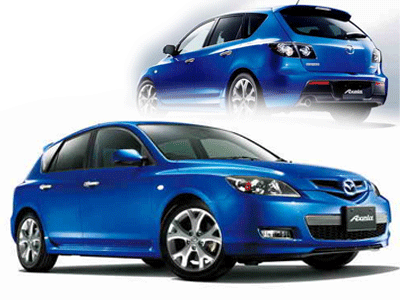COLOGNE, Germany – Ford of Europe will unveil new versions of its top-selling S-MAX and Galaxy at the 2010 Brussels Show on January 13.
With fresh designs and the latest evolution of Ford's kinetic design cues, they feature new interior materials and features, a range of more efficient powertrains and a host of driver-focused technologies aimed at safety and comfort.
The 2010 S-MAX and Galaxy models kick off a busy year for new product introductions from Ford of Europe but, more significantly, herald the arrival of a series of new and innovative technologies and features that, as they are introduced throughout the year, will challenge established perceptions of what Ford cars feel like to sit in and drive.
"We've given both models a fresh new look and more premium appeal, but it is beneath the skin that the major changes have been made," said John Fleming, chairman and CEO, Ford of Europe.
"S-MAX and Galaxy are the first European Ford models to benefit from our global EcoBoost family of direct-injection, turbocharged, petrol engines delivering more power and performance from a lower displacement powerplant, yet with impressive fuel economy and low CO2 emissions. And that is just the start of the 2010 S-MAX and Galaxy story."
These are the first cars to be available with Ford's all-new, high efficiency, 2.0-litre EcoBoost petrol engine. Producing 203 PS (149 kW) it joins a significantly improved 2.0-litre Duratorq TDCi diesel, with 140 PS (103 kW), plus a new 163 PS (120 kW) variant. Additionally, the smooth and effortless Ford PowerShift double wet-clutch transmission system is available for the first time on Ford's large car range; it will be standard equipment with the EcoBoost petrol engine and optional for both Duratorq diesels.
A range of innovative new safety and convenience features debut in the Ford range on versions of the new S-MAX and Galaxy, including a Blind Spot Information System (BLIS®), and new Rear Door Power Child Lock facility.
With the new S-MAX and Galaxy, Ford's design team has achieved significant changes to enhance each vehicle's individual and expressive kinetic design styling.
The S-MAX has been updated with significant detail changes to the exterior including a strongly sculptured bonnet and all-new front fascia, emphasised by the bolder graphic of the gloss black lower front trapezoidal grille.
From the side, S-MAX is instantly recognisable and now stands out even more with its window profile enhanced by a chrome strip, which surrounds the whole glass area to enhance the car's sleek and sporty lines.
The rear of new S-MAX has also been re-designed with a more dynamically profiled tailgate, a lower fascia, and new LED tail lights that extend deep into the rear side flanks, creating an even stronger athletic appearance.
The new Galaxy also features a re-designed frontal section, which emphasises its 'first class travel' appeal and, along with a number of significant other detail revisions, enhance its role as Ford's luxurious, full-size seven seat people mover.
A new, more sculptured, bonnet combines with the Galaxy's new front fascia design – which incorporates a bolder lower trapezoidal grille with inserts featuring subtle chrome bars - and new-look fog lights to emphasise the Ford 'kinetic design' influence. Ghia and Titanium models are differentiated further with chrome bars in the upper grille as well.
The roof incorporates new bolder integrated silver rails for cross bars, while at the rear, distinctive new LED lights and body-coloured lower fascia are standard equipment. Ghia and Titanium series models also receive additional chrome detailing on the side mouldings and door handles.
As with the revised exterior, real attention to detail and high quality execution are key to the new interiors for both models. Carefully balanced new colour and material choices deliver a luxurious and dynamic feel, which helps differentiate the individual personality of each model to meet particular customer tastes and requirements.
COLOGNE, Germany – Ford of Europe will unveil new versions of its top-selling S-MAX and Galaxy at the 2010 Brussels Show on January 13.
With fresh designs and the latest evolution of Ford's kinetic design cues, they feature new interior materials and features, a range of more efficient powertrains and a host of driver-focused technologies aimed at safety and comfort.
"We've given both models a fresh new look and more premium appeal, but it is beneath the skin that the major changes have been made," said John Fleming, chairman and CEO, Ford of Europe.
"S-MAX and Galaxy are the first European Ford models to benefit from our global EcoBoost family of direct-injection, turbocharged, petrol engines delivering more power and performance from a lower displacement powerplant, yet with impressive fuel economy and low CO2 emissions. And that is just the start of the 2010 S-MAX and Galaxy story."
These are the first cars to be available with Ford's all-new, high efficiency, 2.0-litre EcoBoost petrol engine. Producing 203 PS (149 kW) it joins a significantly improved 2.0-litre Duratorq TDCi diesel, with 140 PS (103 kW), plus a new 163 PS (120 kW) variant. Additionally, the smooth and effortless Ford PowerShift double wet-clutch transmission system is available for the first time on Ford's large car range; it will be standard equipment with the EcoBoost petrol engine and optional for both Duratorq diesels.
A range of innovative new safety and convenience features debut in the Ford range on versions of the new S-MAX and Galaxy, including a Blind Spot Information System (BLIS®), and new Rear Door Power Child Lock facility.
The S-MAX has been updated with significant detail changes to the exterior including a strongly sculptured bonnet and all-new front fascia, emphasised by the bolder graphic of the gloss black lower front trapezoidal grille.
Source: Ford









